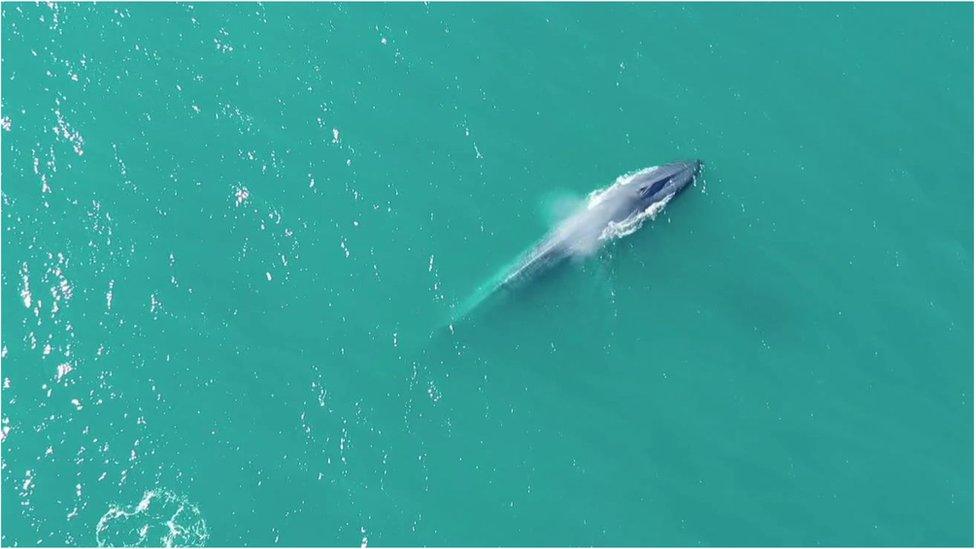South Georgia: The museum at the end of the world reopens for business
- Published
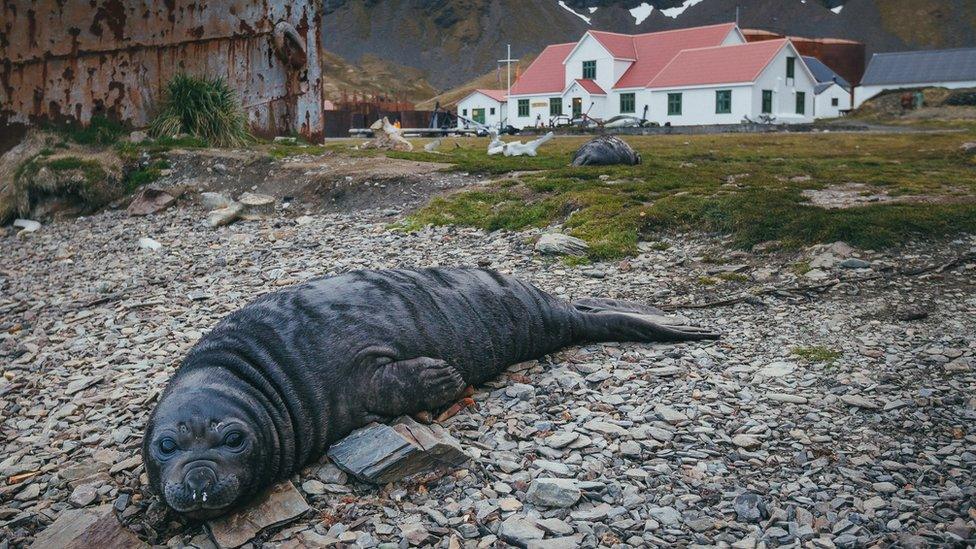
An elephant seal pup in front of South Georgia's museum in Grytviken
On the icy, southern edge of the Atlantic Ocean, just above the Antarctic circle, is a British island, a ghost town, and a museum.
The island is a tough place to work. The nearest airport is a four-day boat ride away. Fresh food is rare, the internet is "poor to non-existent" and, at times, the wind is strong enough to tip over helicopters.
There are no permanent residents on South Georgia, just 20 or so workers, from scientists to maintenance staff. But despite the remoteness, and the pandemic, its museum has reopened to visitors.
It's not easy running a museum at the end of the world. But this - from week-long commutes to imports of frozen cheese - is how they do it.

With no native population, the South Georgia museum staff must come from abroad when it opens for the southern hemisphere summer. Most, but not all, come from the UK - around 8,000 miles north.
That journey normally begins with an 18-hour RAF flight from Brize Norton in Oxfordshire to the Falkland Islands, with a two-hour stop in Cape Verde, external off the coast of Africa. From the Falklands, workers hitch a lift on a fishing patrol boat, with the 1,000-mile journey taking between four and six days.
"If it goes well, it's a week's commute from the UK," says Sarah Lurcock, director of the South Georgia Heritage Trust., external But it does not always go well.
"I have been on the boat [leaving the island] when it suddenly went off in pursuit of a suspected poacher. I missed a family holiday, because it was three weeks before I got home."
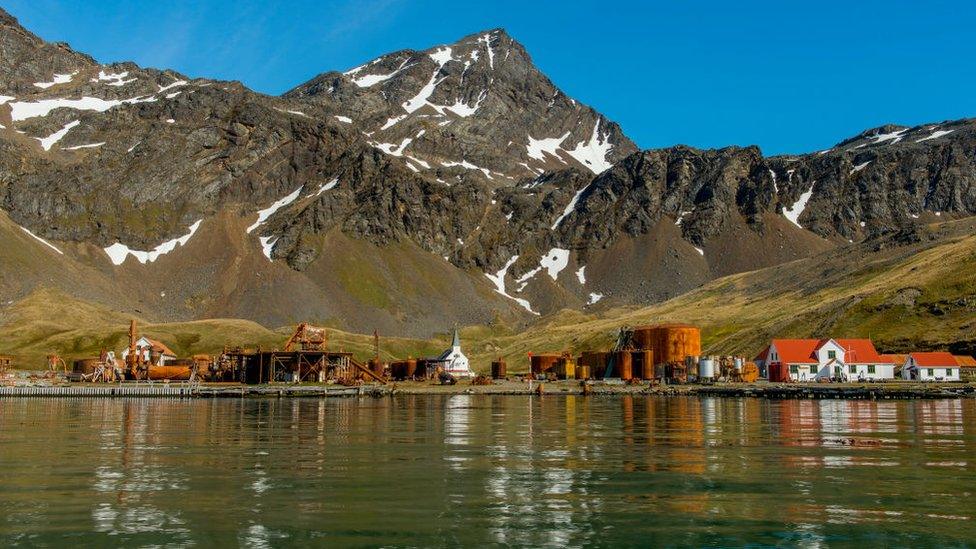
The centre of Grytviken, as seen on approach. There is also accommodation along the shore at King Edward Point
The other way workers reach South Georgia is via cruise ship - usually via Ushuaia on the southern tip of Argentina - and it is those ships that bring visitors to the museum.
Pre-Covid, there would be around 100 ships every summer, bringing 10,000 visitors to South Georgia - almost all visiting the free-of-charge museum. Then in March 2020, Covid-19 rushed across the world, and the South Georgian government - based in the Falkland Islands, external - asked the museum team to leave. There was not much time to pack.
"We literally couldn't remember if we had left paint pots and ladders out in the middle of the museum," says Sarah.
The 2020-21 season was cancelled, and it was thought this season would be, too. But, in November, they were told they could reopen, with two weeks to find a team and hitch a ride on the boat. Doors opened in December.
Normally, five or six staff spend the season at the museum, but this year it was three, plus an artist working on a project. One of them was Jayne Pierce, museum curator, who has recently returned to the UK.
"Already I want to go back - it is infectious and addictive," she says. "The sights, the sounds and the smells are overwhelming."
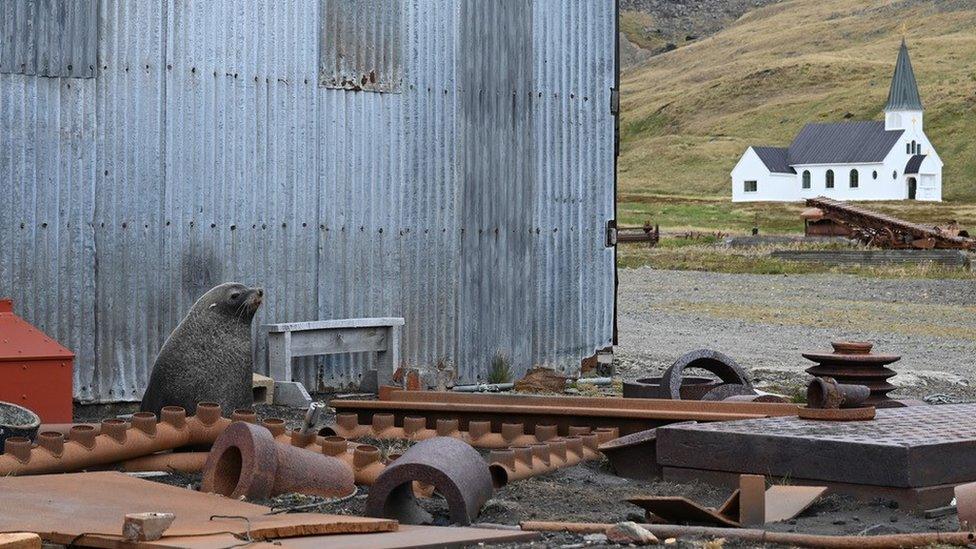
The timber church on Grytviken, more than 100 years old, is still used for services
As a child, Jayne loved penguins, and dreamed of travelling to Antarctica. She graduated with a geology degree in 1992 but, back then, certain jobs at the British Antarctic Survey - which has a team on South Georgia - were not open to women (the policy was changed later that decade, external).
Instead, she became a museum curator and in 2019, saw the advert to run the museum on the island. "It was an exciting moment, and actually emotional," she says.
The first time Jayne went, for a six-month stint, she took a "huge stack" of books, plus paints and pencils, thinking the edge-of-the-world wilderness would give her time for improving hobbies.
"I even considered becoming a yoga aficionado, taking a few yoga DVDs," she says. "But the reality is very different."
On the island, "there is always so much to do" - from museum work, to cooking and cleaning. When there is downtime, the teams hike, watch films, or engage in that old-fashioned pastime: conversation.
"Every person who works on the island has a skill-set very unlike your own," says Jayne. "So there is so much to learn and talk about."
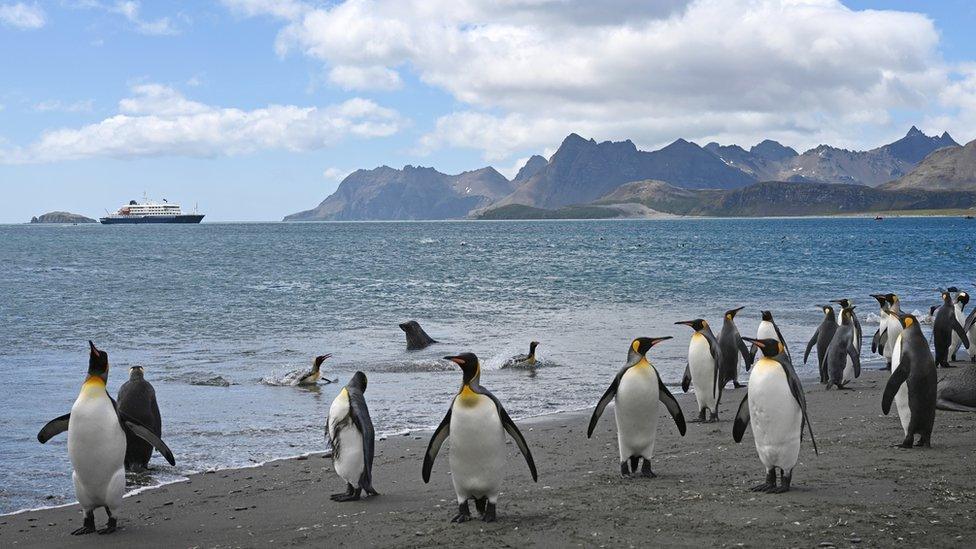
South Georgia is over 100 miles long, and 20 miles across at its widest point
One thing they don't do is endlessly scroll through their phones.
The internet comes via a satellite, first installed for a US university team, and is patchy at best. Emails "dribble in and out". Sending a picture via Whatsapp is a rare achievement. There are plans to improve the signal, but people who work on the island say being cut-off adds to the charm.
"Stepping away from the world has been a treat," says Jayne.
Less pleasant, perhaps, are the food options: most is either tinned, dried, or frozen - including the cheese.
"In normal life I don't consider myself a big salad lover, but I crave it when away," says Jayne. "I'm also a big tea drinker - and you never quite get used to powdered milk."
That craving for fresh food is backed up by a TripAdvisor review, external from November 2017.
"Some of the staff from the museum came on board to tell us a bit about whaling," writes the Californian tourist. "They joined us for breakfast and could not get enough fruit."

The new post office, complete with British lamp box, was opened by Princess Anne on a royal visit in 2016
So, could you work in one of the most remote places in the world?
The South Georgia Heritage Trust, which runs the museum, is based in Dundee in Scotland and has full-time staff - including Sarah and Jayne. But they also recruit seasonal workers to send south, and have an internship., external
"We've had staff from Europe, Australia, it can be absolutely anywhere," says Sarah. "Very often they're people with experience of working in a remote place with a small team."
As if to prove the point, there are currently two museum staff on the island. One is from the Falklands; the other has worked in the Scottish Highlands and Port Lockroy on the British Antarctic base.
They rarely need to advertise, as most workers contact them, having heard of the island, visited it, or worked there already.
"What we're looking for is people who will muck in," says Sarah. "You have to do everything from pumping diesel into our fuel tank, to keeping the cemetery tidy."
Workers also need a certain degree of bravery. "We have breeding, aggressive fur seals, right here, sometimes literally on our doorstep," says Sarah. "If you've got an alternative exit, you will go the other way, because you do not want to disturb them."
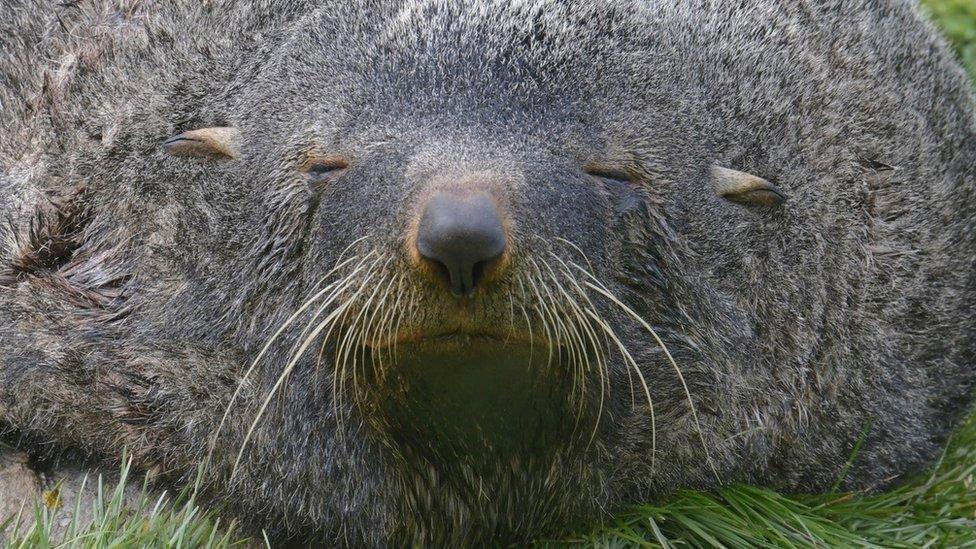
A South Georgian seal in a more docile mood
Though it's closer to South America - and the South Pole - than to London, South Georgia has been a British island since the 18th Century, having been claimed by Captain James Cook., external
The Queen is head of state; the flag features the union jack. But the name of the ghost town where the museum sits, Grytviken (pronounced Grit-vicken), gives a clue to the island's history.
The settlement was named by Swedish explorers in the early 20th Century (the name means Pot Cove). In 1904, Norwegians opened a whaling station there - that is, somewhere to process the whales' meat, blubber, and bones.
In the next 60 years, more than 175,000 whales were killed in the waters of South Georgia alone - processed at Grytviken and other stations along the shore. But, by the 1960s, the industry had burned itself out: there were not enough whales to catch.
Grytviken was abandoned; the rusting jetties, oil tanks, and barracks a reminder of the great 20th Century whale rush. But the relatively grand manager's villa - built in 1914 - remained usable.

After being harpooned with explosives from "fast" boats like this, whales were dragged to processing stations. The largest processed at Grytviken, in 1912, was more than 33 metres long
In 1989, David Wynn-Williams, a British Antarctic scientist, suggested turning the villa into a museum, external. The project was taken on by Nigel Bonner and it opened in 1992, originally focused on whaling, but now with a broader approach.
It is arguable whether South Georgia's museum is the remotest in the world. There is, for example, one on Port Lockroy - the British base on the Antarctic peninsula - and one on Pitcairn,, external a British territory in the Pacific.
But what is certain is that, standing on the South Georgia shore, taking in Grytviken's ghost-town vista, you feel a long way from anywhere.
"The escape from all the background noise is refreshing," says Jayne. "It soothes the soul."
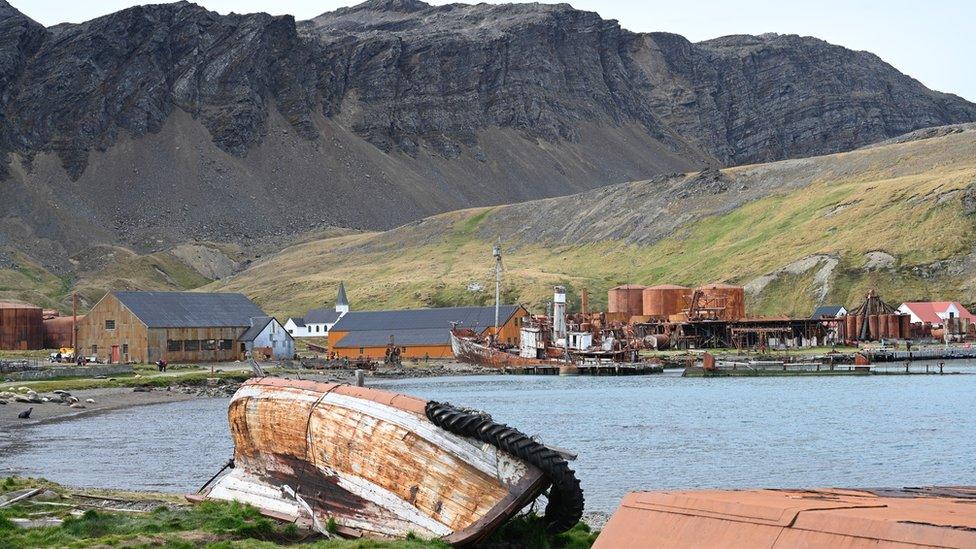
The disused buildings include a blubber cookery, a meat plant, and workers' barracks
Although the museum reopened this season, it was not business as usual.
The government classes cruise ships as red, amber, or green, depending on their perceived Covid risk., external Passengers on green ships can visit as normal; red ships can land on the island - but not visit Grytviken. Amber is somewhere in between.
The staff estimate that less than 20% of ships have been green - and there are fewer ships to begin with, carrying fewer passengers. Visitor numbers have been in the hundreds, rather than the 10,000 that came every year pre-Covid.
It is a particular shame, because 2022 is 100 years since the death of South Georgia's most famous son. Sir Ernest Shackleton famously reached the island in 1916, after an epic escape from the icy grip of the Antarctic Circle, and died while docked in Grytviken on 5 January 1922., external
He is buried in Gryvitken's cemetery and many tourists still toast the grave with a tot of whisky. But, while there are fewer in-person visitors, the museum's website, external - packed with pictures, maps, exhibitions, and stories - is reaching a global audience.
"It's not just a museum for the relatively few people who can go to the island," says Sarah. "We have long wanted to make it available to the world, but we haven't had the resources. Last year [while the museum was closed] we got to grips with it."
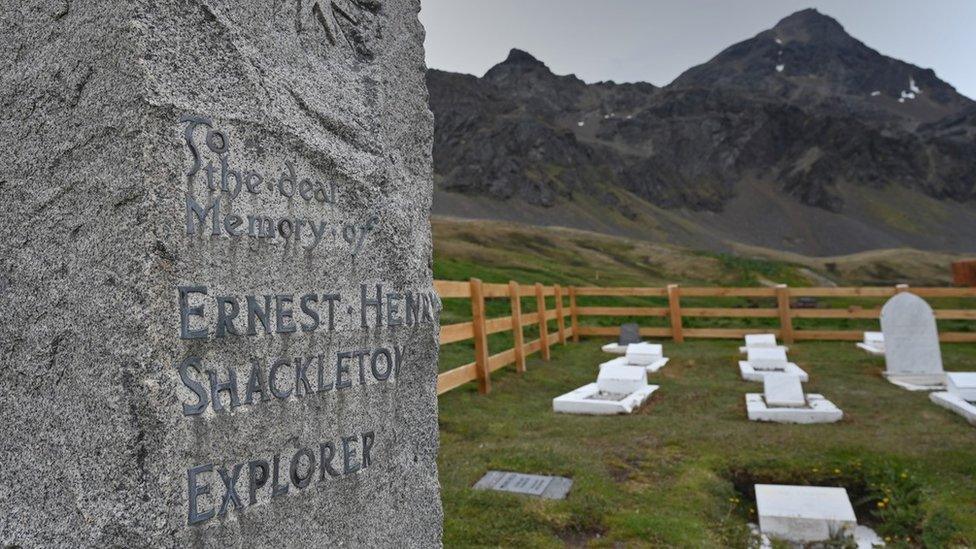
After his remains were initially sent to South America, Shackleton's wife insisted he was buried in South Georgia. His body faces south, rather than the Christian tradition for east, as a nod to his life's work
The expansion of the website is part of a broader plan to tell South Georgia's story to the world.
"South Georgia is a British Overseas Territory, and it's actually a jewel in terms of wildlife," says Alison Neil, the chief executive of the heritage trust.
"It's got the greatest concentration of seabirds on Earth. Whale populations are recovering. Native birds are recovering thanks to the work we did to eradicate rats and mice., external The fur seals, the elephant seals, are back to pre-hunted numbers. This is a good news story, and it's to a very large extent down to the fact it's being looked after by the UK."
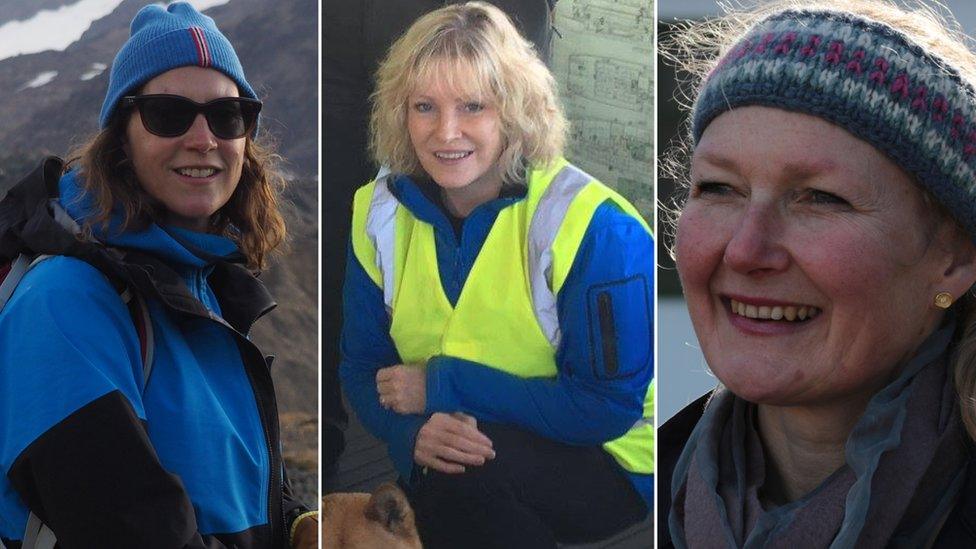
Jayne Pierce, Alison Neil, and Sarah Lurcock (picture credit: Roland Gockel)
So the island, and the museum, may just be specks at the bottom of the globe, fuelled by powdered milk and frozen cheese. But they both have something important to say about the world, says Alison.
"We've got an obligation to educate people about the stories of South Georgia's past, which was unsustainable in terms of how we dealt with nature," she says.
"If humanity can turn around its attitude, and start to protect nature instead of exploiting it, then amazing things can happen. South Georgia is a little microcosm of what's possible for the wider world - if people start to care about places and not exploit them."
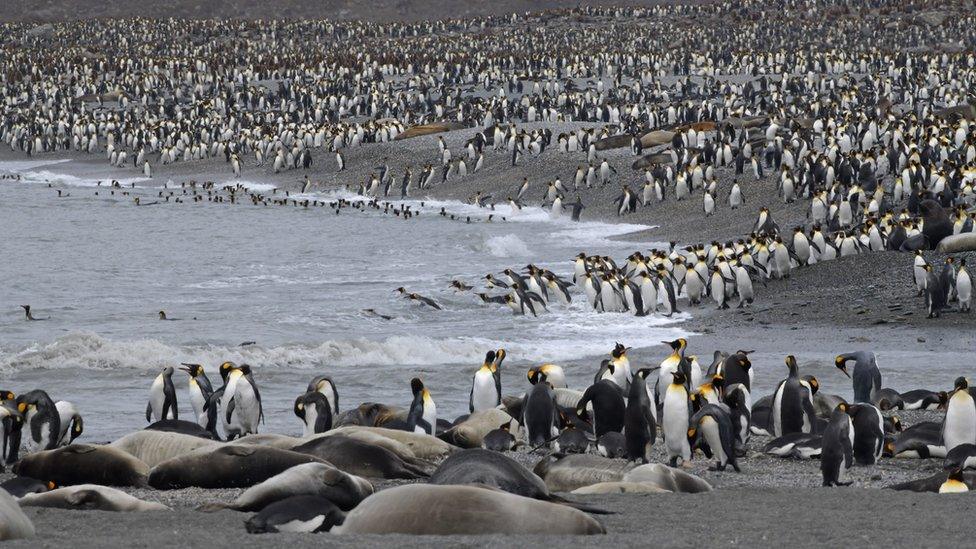
Follow Owen @owenamos, external
- Published14 December 2021
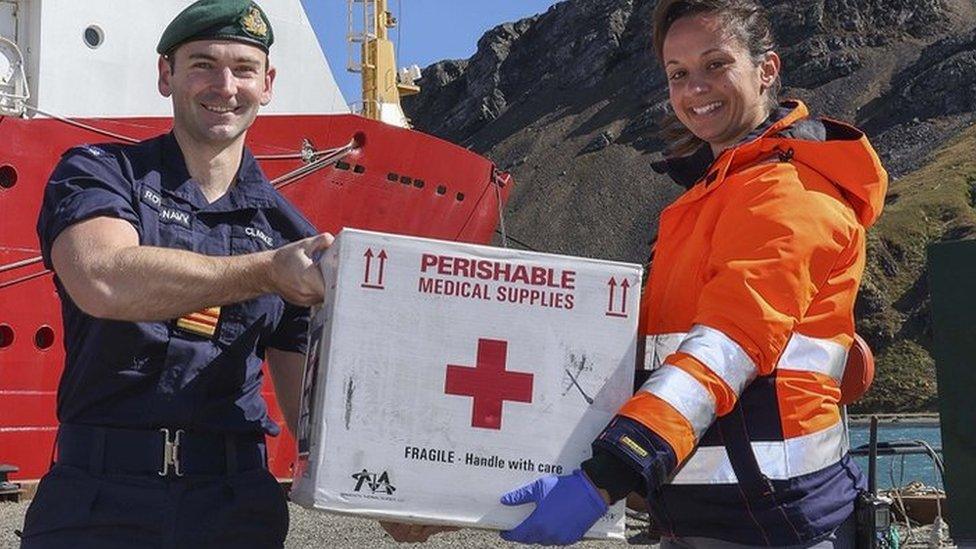
- Published17 September 2021
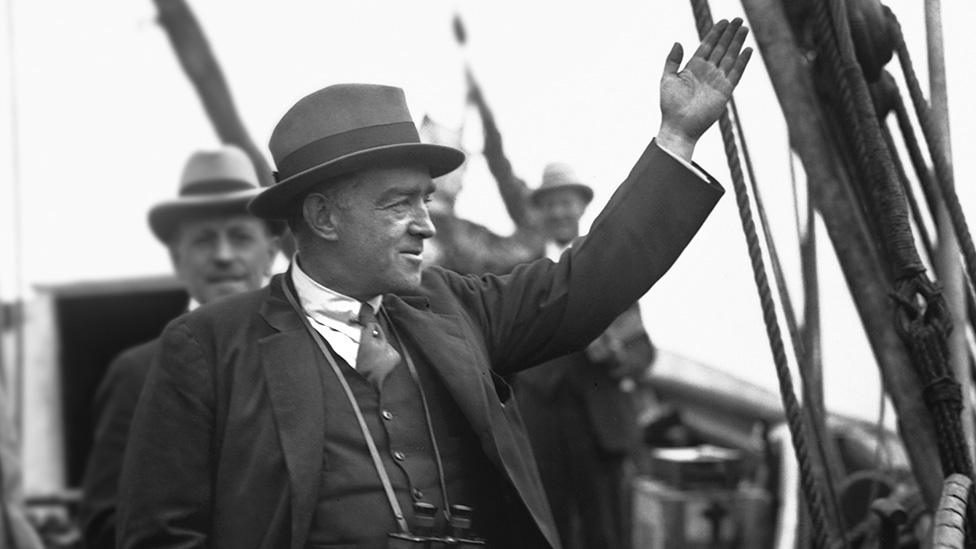
- Published19 November 2020
